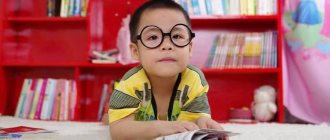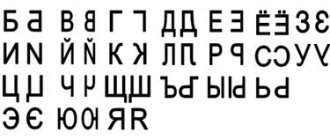When oral speech suffers, everything is clear, a speech therapist is required. When written language suffers, you need... what? Severe punishment for lack of diligence? Or “you just need to teach better,” as liberal-minded parents say?
Sometimes it’s “better to teach.” And sometimes - both to teach and to heal a little. And in general, you will have to turn to a speech therapist (yes, and with written speech too) so that he can figure out whether emergency speech therapy help is needed. Some parents are very surprised when the school advises them to check with a speech therapist. And they are even more surprised when the speech therapist advises to work out. And under no circumstances should you use a belt or other medieval methods of influencing a person. The speech therapist also says the word dysgraphia, which means a disorder of written speech.
Diagnosis of dysgraphia
By what signs can you guess that a child has dysgraphia? First of all, if he makes mistakes when writing... let's say, strange ones. They are not associated with violation of grammatical rules. It is impossible to find rules for these errors. Errors occur in completely innocent words, the spelling of which does not allow for ambiguity.
Instead of “house” he writes “don” or “tom”, instead of “for” he writes “dyal”, instead of “cat” - “who”, instead of “came” - “sat down”, “squirrel” turns into “block” and so on Further. The child may not complete words, insert extra letters, or skip them.
One 11-year-old boy wrote during the examination: “The girl hid in a tree.” The phrase was dictated to him: “The squirrel hid in a hollow.” When asked how we write prepositions, the sufferer answered correctly - “separately.” He knows the rule, but cannot apply it in practice.
But this child is not bad, not stupid, he is very nice. He just has a hard time writing. Only special exercises and self-confidence can help.
People with dysgraphia often have very poor handwriting - small or very large, illegible. It’s hard for a child to follow the line, the words run into the fields, onto each other, slide off the line or suddenly fly over it, the word is free birds. Also, young dysgraphics do not complete endings. They may write in a mirror way, turning the letters over, they may not complete certain elements of the letter or they may add extra ones.
When a child is just learning to write, he may still have such strange mistakes at the very beginning of his learning, but they quickly disappear. A person with dysgraphia is very slow to master literate writing. One gets the feeling that he is uncomfortable writing, he doesn’t like to do it. And indeed it is. Often, a schoolchild seems scared by the sheer volume of what needs to be learned, read, and written. And when they also scold you for failures, you completely give up.
Common dysgraphic errors
In writing, dysgraphia manifests itself in the following specific errors:
- Replacing vowels with other letters. Very often, children even replace vowels that are in a stressed position (for example, a dysgraphic student can easily write “December” instead of “December” and not notice this mistake).
- A mixture of letters that sound almost identical.
- Separate writing of prefixes, combined writing of prepositions.
- Errors in the agreement of words in a sentence.
- Omissions (rearrangement, addition) of extra syllables, letters.
- A mixture of letters that are similar in style. With dysgraphia, schoolchildren often confuse the following pairs: Sh-Sh, D-B, N-K, P-I.
- Problems with identifying the boundaries of a sentence, since dysgraphics do not hear (do not feel) its semantic and intonation completeness.
All these specific writing disorders in dysgraphia, as a rule, do not occur in their pure form; in most cases, a mixed picture is observed.
Treatment of dysgraphia
It is better not to try to cope with all problems at once.
You need to choose one and focus on it. For example, a child confuses b-p, d-t, and also confuses prepositions with prefixes. If you take on everything at once, the amount of work can be daunting. But if you try to cope only with b-p, and then draw the student’s attention to the fact that, they say, there are fewer mistakes, then you can awaken enthusiasm. And the struggle for universal literacy will continue to be much more fun. A speech therapist at the clinic will be able to, with a timely visit (at three years old, at five years old and before school itself), determine whether there are any speech therapy problems that will later result in dysgraphia, and, if necessary, recommend special classes. The speech therapist may be joined by a neuropsychologist and a neuropathologist.
I often see very sad children at receptions. They frown when they are asked to write a dictation and immediately admit that they are “bad students.” Then, to cheer them up, I begin to remember various famous people who were also not friends with writing and reading. Maybe a modern child will not be interested in learning that Sergei Rachmaninov, Nikola Tesla, Albert Einstein, most likely, were also dysgraphic, but I think almost any boy will be touched by the information that the great Neo, the winner of the terrible Agent Smiths from The Matrix ”, also had difficulty coping with letters and words in childhood. Well, or rather, actor Keanu Reeves. I usually tell girls about Agatha Christie. Despite the fact that the creator of Poirot and Miss Marple studied poorly and wrote with errors, she became a famous writer. The main thing is to believe in yourself.
Classification of dysgraphia
Currently, there are 3 main approaches to classifying this disorder:
- neuropsychological;
- clinical-psychological;
- speech therapy.
We will not describe each approach in detail, since each of them contains different types of dysgraphia. For example, within the framework of the neuropsychological approach, regulatory, acoustic-kinetic, visual-spatial dysgraphia are distinguished, and speech therapy - acoustic, articulo-acoustic, optical, agrammatic dysgraphia.
Here it is only important to note the fact that within the framework of each approach, specific dysgraphic errors are analyzed and corrected, that is, specialists work on a specific, clearly visible problem.
However, to effectively overcome dysgraphia, it is necessary to eliminate its root cause, and not fight its consequences.
Briefly about the main thing: what is dysgraphia?
Dysgraphia is a specific and persistent disorder of the writing process, caused by deviations from the norm in the activity of those analyzers and mental processes that ensure writing.
The disorder occurs in both children and adults. In children, damage or underdevelopment of the corresponding parts of the cortex is most often associated with the pathology of pregnancy or childbirth in the mother, or injuries.
Symptoms: specific and repeated errors in writing, not related to ignorance of grammatical rules. The peculiarity of these errors is as follows: they are made where writing words does not seem to cause any difficulties.
Correction of dysgraphia using the method of Tatyana Goguadze
The experience of the Tatiana Goguadze Dyslexia Center proves that writing dysgraphia is explained by a mismatch in the functioning of the brain hemispheres and a lag in the development of the functions of the left hemisphere.
Important! We are talking about children with intact intelligence who do not suffer from diseases associated with brain functioning.
To overcome the discrepancy in the functioning of the hemispheres of the brain, it is necessary to form the correct neurodynamics of reading and writing, develop hand-eye coordination, graphic skills and strengthen the muscles of the hands to relieve tone from the wrists.
To correct dysgraphia, it is recommended to perform special physical exercises.
Graphic correction – a basic exercise for dysgraphia and dyslexia
This is the original method of speech pathologist teacher Tatyana Goguadze for solving problems with reading and writing. During classes, the work of brain rhythms changes, thanks to which the child, and even the adult, begins to see what he writes, his handwriting becomes more fluent and accurate, and his reading becomes meaningful.
Additionally, graphic correction helps:
- develop endurance for monotonous work;
- teach a child with dysgraphia to see the whole word, not to lose a line and follow it with his eyes;
- get rid of strong pressure on the handle, as the strength of the hand and the feeling of your body develop.
If this exercise is difficult, then to overcome dysgraphia in younger schoolchildren, you can start by coloring outline pictures. The main thing here is not to go beyond the contours of the drawing, and the hand should move strictly in lines from left to right. Careful coloring is also very important; there is no need to chase the speed or number of colored pictures.
Five types of dysgraphia
Articulatory-acoustic form of dysgraphia
The child writes as he hears. If all sounds are not delivered by the school period, problems with writing may arise.
For example, a child replaces “r” with “l” in oral speech. And instead of “rum” he writes “loma”, instead of “gunpowder” - “polokh”. Or, if the sound is completely absent in speech, it may be completely missed. For example, write “koshun” instead of “kite”.
Acoustic form of dysgraphia
The child can pronounce all sounds clearly, but at the same time replaces letters denoting phonetically similar sounds. In writing, pairs of letters are most often mixed: d-t, b-p, zh-sh, v-f, g-k or s-sh, z-zh, ch-shch, ch-t, ts-t, ts-s .
Dysgraphia due to impairment of language analysis and synthesis
Most often occurs in children suffering from written language disorders. With this form of dysgraphia, children skip letters and syllables, rearrange them, do not complete words, write prepositions together or write prefixes separately. Sometimes you can encounter such a violation as contamination: when a word contains syllables from different words. For example, “crabs” are crab sticks.
Agrammatic dysgraphia
As the name suggests, it is associated with underdevelopment of the grammatical structure of speech. There are no grammar rules for such a child. Agreement between nouns and adjectives, nouns and verbs suffers (“Masha ran”, “blue coat”).
Optical dysgraphia
The elements that form letters are few in number: mostly sticks, circles, hooks... But they are combined in different ways in space, forming different letters. But for a child whose visual-spatial representations, visual analysis and synthesis are not sufficiently developed, it is difficult to grasp the differences between letters. Either he will add an extra stick to t, or he will not add a hook to w.
If a child does not grasp the subtle differences between letters, then this will certainly lead to difficulties in mastering the outline of letters and to incorrect representation of them in writing.
2.2. Processing the results of a survey of the writing of schoolchildren in grades 1-4
When studying writing among junior schoolchildren in grades 1, 2, 3, 4, previously selected analysis criteria are used. To characterize the success of mastering writing, the productivity (correctness) of completing written tasks is determined, for which in each written work the number of correctly written words (without errors and corrections) is separately calculated - 1 point, and the number of words with correct corrections (self-correction) made by children - 0.5 points.
This makes it possible to determine an individual productivity indicator not only for each student being examined, but also to compare them among different students.
2. Error assessment.
Isolation of dysgraphic errors is considered impossible if contaminations occur in the student’s written work (combination of elements of three or more words with various combinations of errors in the form of omissions, rearrangements and mixtures of letters and/or syllables within this combination). For such work, a maximum penalty score of 30 points is immediately awarded.
In the absence of contamination, errors are assessed as follows:
1 point - a mistake made and not corrected;
0.5 points - a mistake made, but correctly corrected by the child.
The total amount of points awarded for errors makes it possible to assess the severity of the violation and at the same time characterize the student’s level of control over the writing process, which is determined by subtracting from the total number of errors made the number of errors found and correctly corrected by the child. All types of written work performed are assessed in a similar way: dictations, copying from printed and handwritten texts.
All detected errors are divided into dysgraphic, dysorthographic, agrammatic and metalinguistic. To establish dysgraphia in written works, only errors of the first group are analyzed in detail.
Dysgraphic errors include those associated with a violation of the implementation of the phonetic principle of writing in a strong position in a word. The phonetic principle involves writing a word in full accordance with its pronunciation. Replacing any letter in a word when using this principle when writing turns out to be impossible, since in this case a change in the word will necessarily occur (A.N. Gvozdev, 1961; L.P. Zinder, 1987). A strong position should be considered a position in which the phoneme is heard as a basic sound, while clearly distinguishing significant units of language (words or morphemes). Most often, the pre-stress and stress positions in the words “cat” and “hand” are associated with a strong position. The phonetic principle is also used in words in which the weak position is conveyed by letters that have an adequate basic meaning, for example, “five”, “grass”. The implementation of this principle is ensured by the formation of all components of the functional writing system.
The work of a functional writing system is carried out thanks to the interaction of all components involved in it, the immaturity or violation of which, as proven by many studies, causes errors of various natures. If there is a deficiency in the functioning of the left hemisphere, it is possible to make symmetrical replacements of “voiced” consonants with “voiceless” ones and, conversely, “voiceless” with “voiced” ones. With right hemisphere insufficiency, on the contrary, asymmetrical replacements of mainly “voiceless” consonants with “voiced” ones appear.
All errors associated with violation of the phonetic principle of writing are divided into several groups depending on the cause of their occurrence.
Writing errors.
1. Substitutions and mixtures of letters due to the acoustic-articulatory similarity of sounds:
a) voiced and voiceless consonants, including their soft pairs:
- a voiced consonant on a voiceless consonant (“masonry” instead of “smooth”; “osere” instead of “lake”);
- a voiceless consonant for a voiced consonant (“vone” instead of “phone”; “sdebelke” instead of “stelk”).
b) hard and soft consonants, reflected in the mixing of vowel letters (vertically) with each other:
- a vowel of the 2nd row for a vowel of the 1st row (“stalk” instead of “stalk”, “radom” instead of “nearby”);
- a vowel of the 1st row to a vowel of the 2nd row (“high” instead of “high”, “föne” instead of “fone”);
vowels of row 1 A O U E Y;
vowel letters of the 2nd row I YE YE I.
Errors of this nature are made by schoolchildren who, during examination of oral speech, discover violations of phonemic perception when distinguishing hard and soft sounds by ear.
From those mentioned above, one should distinguish errors whose mechanism of occurrence is associated with the inability to master various ways of denoting soft consonants in writing while maintaining the ability to distinguish between hard and soft consonants by ear in oral speech.
Errors in indicating softness of consonants:
- replacing the vowel of the 2nd row with b (“loved” instead of “admired”, “green” instead of “green”);
- replacing the vowel of the 2nd row with b + vowel (“admired” instead of “admired”);
- replacing the vowel of the 2nd row with Y + vowel (“zemlya” instead of “earth”);
- replacing the vowel of the 2nd row with Y at the end of the word (“heron” instead of “heron”);
- replacing b with a vowel (“leaves” instead of “leaves”, “admired” instead of “admired”, “vesi” instead of “all”);
- omission b (“bolshoy” instead of “big”, “stalk” instead of “stalk”);
- replacing the dividing b with J, J + or b (“sparrows” instead of “sparrows”).
Errors in marking softness are not dysgraphic.
c) whistling and hissing consonants:
- a whistling consonant to a hissing consonant (“wonderful” instead of “wonderful”, “it turned out” instead of “it turned out”);
- a hissing consonant for a whistling consonant (“snowdrops” instead of “snowdrops”, “slusny” instead of “audible”).
d) affricates and their components:
- consonant sound C to consonant Ch (“bloomed” instead of “bloomed”, “bloomed” instead of “bloomed”);
- consonant sound Ch to consonant sound C (“wonderful” instead of “wonderful”);
- affricates into components of affricates (“light” instead of “flower”, “blown” instead of “bloomed”);
- components of affricates into affricates (“tsemnoy” instead of “dark”, “dark” instead of “dark”),
e) back lingual consonants (k-x, g-x, including their soft pairs):
- stop consonants (K, G) on fricative (X) (“come running” instead of “running”, “holos” instead of “voice”);
- slotted (X) into occlusives (K, G) (“shoroki” instead of “rustle”, “cheryomuka” instead of “cheryomukha”),
f) sonorant consonants (including soft pairs):
- vibrant P on the transitive consonant L (“klasiv” instead of “beautiful”, “ozela” instead of “lake”);
- closed-passive consonant L with vibrant R (“korabriki” instead of “korabliki”, “steberek” instead of “stalk”),
g) vowel letters, manifested in mixing of vowel letters with each other (horizontally).
A - O - U - E - S
I—Y—Y—E—I
- vowel letter of the 1st row to the vowel letter of the 1st row (“tsvetomi” instead of “flowers”, “glodkoy” instead of “smooth”);
- a vowel letter of the 2nd row to a vowel letter of the 2nd row (“plates” instead of “plates”, “loved” instead of “admired”);
h) consonants similar in the method of formation: p-k, s-x, t-k, etc.
- for example, “hobachka” instead of “doggie”, “kam” instead of “there”;
i) consonants similar in place of formation: p-m; t-n, n-l, etc.
- for example, “then” instead of “but”; "lad" instead of "over".
2. Optical errors:
Errors in writing visually similar letters (“om” instead of “house”).
Written Achievements – Previous | next – Written works
Neuropsychological diagnostics, examination of writing and reading of primary schoolchildren
Consultation with a psychologist for neuropsychological problems
Forewarned - almost forearmed
It is better to prevent dysgraphia at an early age, without waiting until problems suddenly arise in the second or third grade, and the child develops an aversion to studying. You should keep an eye on the child and closely monitor the process of mastering written language:
- if the child attended a speech therapy kindergarten;
- if there was a delay in speech development at 2–3 years of age;
- if the child has problems with memory and attention;
- if the child is left-handed or a retrained left-hander;
- if the child has had head injuries;
- if by the age of seven the violations of sound pronunciation have not been corrected.









